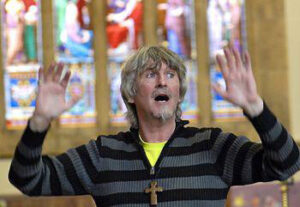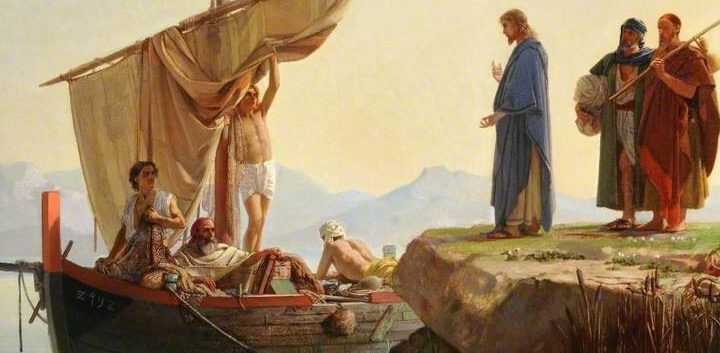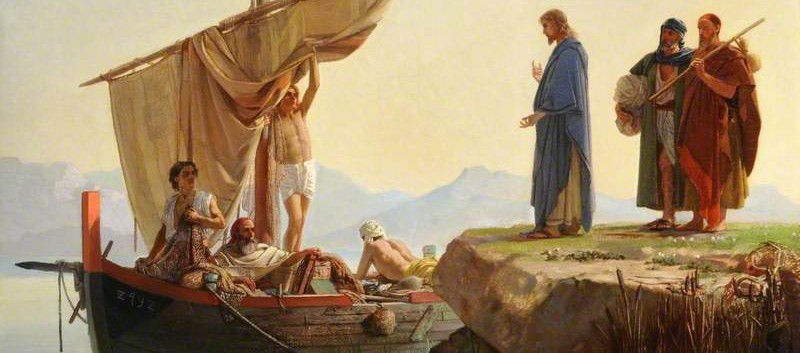Do you remember singing the children’s Sunday school song “I will make you fishers of men”? Often it accompanied learning the biblical narrative of Jesus calling his first disciples, Simon Peter and Andrew.
This stirring song so captured our imaginations with boats, nets and fish, that we young children enthusiastically and without reservation agreed to follow Jesus. Later, as teens at church camp, we might have sung the old commitment hymn “I Have Decided to Follow Jesus,” soberly promising “no turning back.”

Beverly Howard
“Will You Come and Follow Me” also known as “The Summons,” is a modern hymn by John Bell and Graham Maule that offers a mature call to discipleship and witness that challenges us to ponder what following Christ may mean.
The phrase, “Will you come and follow me?” suggests what Jesus expects of his followers. This text does not itemize the requirements for discipleship; it poses difficult questions to a would-be follower.
In structuring this hymn, the authors employ an ancient teaching method, the Socratic method, in which students learn by probing a subject with questions but are not supplied answers. Jesus frequently used the same technique when he interacted with people, requiring them to examine their lives and spiritual motivation.
“The authors employ an ancient teaching method, the Socratic method, in which students learn by probing a subject with questions but are not supplied answers.”
The hymn’s first four stanzas sing through the voice of Jesus, who poses 13 questions to potential followers. The fifth stanza sings in our voice, our response. As the stanzas unfold, the questions delve deeper, designed to reveal the reality of discipleship.
In the first stanza, Christ queries our willingness to go to unknown places. Simple enough. The question seems innocuous, luring the singer to a life of adventure. A person might eagerly respond and commit to going, not unlike our childhood response to “I will make you fishers of men.” However, the questions in the next three stanzas become more penetrating, more personal, more radical.
The second stanza begins with an unexpected question: Will we leave ourselves behind? Throughout his ministry, Jesus required his followers to leave people, livelihood and things behind, to abandon their nets (Mark 1:16–18), leave their families (Luke 9:59–62), or give up everything (Mark 10:28). However, this question asks if we are ready to leave behind those parts of ourselves that hinder us from caring for all people. Not just the likable, lovable folks, but will our care extend to those outside our comfort zones? Are we prepared for any hostility aimed at us when our work in Christ’s name is counter-cultural?
The questions in the third stanza may sing to the heart of this hymn, indeed, the heart of following Jesus. How will we love? Will we practice radical discipleship? This stanza probes deeply, requiring more than a literal understanding of two questions: Will we “let the blinded see” and “kiss the leper clean”? As Bell notes in their collection Heaven Shall Not Wait, he frequently uses surprising turns of phrase and images in his hymn texts to call people’s attention to the God who “can be expected to surprise, contradict, upset or rile us in order that the kingdom may come.”
“Bell frequently uses surprising turns of phrase and images in his hymn texts to call people’s attention to the God who ‘can be expected to surprise, contradict, upset or rile us in order that the kingdom may come.’”
Neither question refers to literal blindness or leprosy, but rather spiritual conditions. Humanity is easily blinded by bigotry, greed, power and a host of other failings. Sharing and showing God’s love gives people an opportunity to envision and live a more promising, hopeful life through Christ.
Although the authors’ image of “kiss the leper clean” is shocking, they are not describing a literal, physical condition or action. Our society cruelly ostracizes and marginalizes people who are deemed different, resulting in them living as isolated as any person quarantined with an infectious disease such as leprosy. Christ summons us to lavish love on them by entering into their anguish, fear, confusion, pain and loneliness.
The next stanza poses an extremely intimate question: “Will you love the ‘you’ you hide”? Many people hide some aspect of their true self, their “you.” Why? Perhaps for a myriad of reasons such as shyness, distrust or fear, people choose to live their lives and faith behind a mask or façade. In so doing, their unique self, with all its God-given gifts and talents, is lost.

Graham Maule
Dropping the facade requires courage and faith, which prompts the next question in this stanza: Do we have the courage to quell our internal fears and use our faith to reshape the world?
The entire final stanza is an affirmative response to Christ’s summons. Not only does this stanza permit the singer to respond after the seeming barrage of questions, it also echoes several phrases the authors employ as litanies throughout the hymn.
For example, the first question in stanzas 1-4 ends with “if I but call your name.” The second question in stanzas 1-4 ends with “and never be the same.” Not only do these phrases provide structure and unify the text, they serve to reinforce the immediacy of responding to Christ’s call and the resulting transformation of lives. The last line of each stanza contains some variant of Christ in us and us in Christ, expressing the life in Christ as organic, growing and never static. The hymn’s last line alludes to Acts 17:28: “For ‘in him we live and move and have our being.’”

John Bell
This hymn, commonly known as “The Summons,” is the collaborative effort of two Scottish hymnwriters associated with the Iona Community, John Bell (born 1949), a theologian and musician, and Graham Maule (1958-2019), a visual artist. Their vocational paths led them to the Iona Community where they embarked on a new ministry of worship renewal, focusing on congregational singing. Seeking to write songs that were contemporary with people’s lives, they collaborated on numerous hymns and liturgical resources published by the Wild Goose Worship Group.
Several years ago, I discussed “The Summons” with Bell and he related that they wrote it to mark the conclusion of a youth volunteer’s time of ministry. Although this hymn was intended for a one-time purpose, the text so resonated with people that it now appears in more than 40 hymnals and hymnal supplements.
Both Bell and Maule valued traditional folk songs, frequently using them as the musical medium for their texts. “The Summons” is set to the Scottish tune KELVINGROVE.
Beverly A. Howard lives in Fort Worth, Texas. She is a retired university music professor, former editor of The Hymn: A Journal of Congregational Song, and member of hymnal committees that prepared Glory to God: The Presbyterian Hymnal and Celebrating Grace: Hymnal for Baptist Worship. She is a collaborating author for the forthcoming hymnology textbook Sing with Understanding: An Introduction to the Theology of Christian Congregational Song with Martin V. Clarke, Geoffrey Moore and C. Michael Hawn.
Related articles:
Hymn stories: ‘Christ is alive! Let Christians sing’
Hymn stories: Lord, Who Throughout These 40 Days


